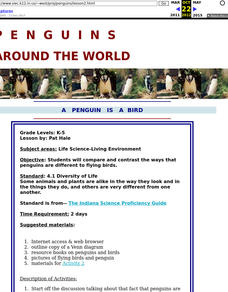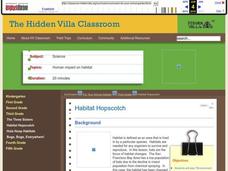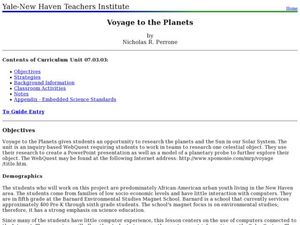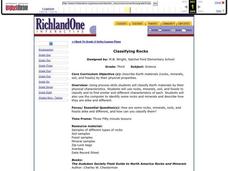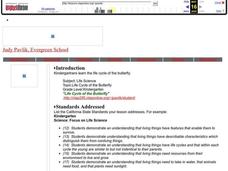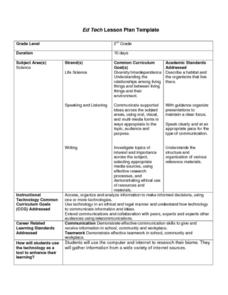Curated OER
Symbiotic Relationships
Seventh graders research types of symbiotic relationships on the Internet and explain what the effects would be in one of the species disappears. For this investigative lesson students use the Internet to do research then participate in...
Curated OER
Night Hike
Students explore Upham Woods at night and investigate about the special adaptations of nocturnal animals. They identify three nocturnal animals and how they are adapted to the night. Students explain what night vision is and how it works.
Curated OER
Walking the Talk
Students research production, consumptions, and disposal of everyday items and their ecological impacts. In this sustainable economics lesson, students discuss clothing and various items used everyday in groups. Students then study a...
Curated OER
A Penguin is a Bird
Students compare and contrast the ways that penguins are different to flying birds.
Curated OER
Seabird Survival Adaptation Card Game
Students study seabirds and how they have adapted to their environments. In this activity based instructional activity students will play a card game that will allow them to have a better understanding of seabirds and their adaptations.
Curated OER
Habitat Hopscotch
Third graders explore animal characteristics by participating in a bat environment game. In this natural habitat lesson, 3rd graders identify the physical anatomy of a bat and discuss their eating and sleeping habits. Students conduct a...
Curated OER
Voyage to the Planets
Students examine the planets in the solar system. In this planetatry lesson students complete a project using a WebQuest program.
Curated OER
Classifying Rocks
Third graders classify rocks. In this rocks and minerals lesson, 3rd graders observe, make inferences and conclusions about rocks, minerals, soil and fossils.
Curated OER
FACS:Nanotechnology and "Smart" Textiles (IT)
Students obtain an understanding of the term "nanotechnology" and how nanotechnology products be used.
Curated OER
Life Cycle of the Butterfly
Students listen a variety of books on butterflies and are introduced to their life cycle. In groups, they describe the life cycle in the correct order and watch the life cycle from larva to the butterfly in a demonstration. To end the...
Curated OER
In Your Own Backyard
Young scholars observe organisms in their habitat and record their observations. They then draw conclusions about the organism's habitat needs and food sources.
Curated OER
Ya' Gotta Have Heart
Fourth graders study the parts of the human circulatory system and how they function. They design a flow chart of the circulatory system and use data to construct charts and graphs.
Curated OER
Creatures of the Ocean
Second graders examine the characteristics of a specific ocean creature. In pairs, 2nd graders create a graphic organizer to list categories and supporting details of the ocean creature. Students review data and use it to write a report...
Curated OER
Notes on Cell Organelles
Students record information and write journal entries on the structure and function of cell organelles while viewing a Powerpoint presentation.
Curated OER
Gwynns Falls
Students investigate the question: What is the impact of urban development and expansion on the health of a decidious forest ecosystem and humans? They examine the issue of land development by responding to a specific scenario and...
Curated OER
Ecosystems
Third graders create an ecosystem for red wiggler worms to observe as they work on a complete unit.
Curated OER
Bat's a Fact
Second graders investigate the truths and misconceptions associated with bats. By illustrating the characteristics and uniqueness of these often feared and misunderstood creatures, 2nd graders increase their awareness of these nocturnal...
Curated OER
Organisms and Habitats
Second graders investigate biomes and the plants and animals that are native to particular biomes. They participate in a class discussion, conduct Internet research on a selected biome, and create a shoebox biome using their Internet...
Curated OER
What is an Animal Group?
Students discover that people live in groups and animals live in groups or alone. They list ways that families cooperate and work together as a group. They create a large dinosaur made out of geometric shapes.
Curated OER
Who Can Harvest A Walleye?
Seventh graders investigate the concept of how an ecosystem is put together while conducting research using a variety of resources. They correctly differentiate between a herbivore and carnivore by placing them in the order of hierarchy...
Curated OER
Birds of A Feather
Students observe and record the many types of birds they see in a month. They discover the many patterns birds follow and compare their results with other classrooms. They complete a field assessment as the final activity for this lesson.
Curated OER
Parasites: Our Tiny Companions
Students consider parasites that seek human hosts. They prepare nutrient agar plates and cultivate samples of bacteria taken from their own bodies. They experiment with disinfectants and soaps to determine which method kills the most...
Curated OER
Leaf Slides
Pupils, in groups, examine leaf slides in order to explore the detail in leaves.
Curated OER
Twisted Vision
Students explain polarization vision and why some animals have it while others do not. They examine the reasons why it would be helpful for marine organisms to have polarized light.





